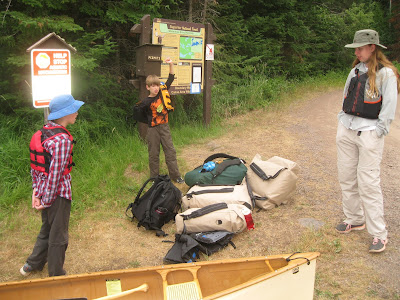Wow - 2 months went by in a flash, and I haven't posted a single update. That's just a sign of the busy times we're in. Lots going on.
A month ago, we were in the Boundary Waters on this day of the month. It was a good trip, despite some mechanical challenges getting there and back. Here's just a few pictures.
After 750 miles of travel, we made it to our entry point of "Homer Lake" on an overcast morning. We had 3 kids, 6 packs, and 2 canoes. That's all we were able to manage to take.
#1 Kiddo learned how to portage canoes on this trip. And she did just great. Below, here she is portaging our 59 pound Kevlar canoe up and over a pass. I was quite pleased with her abilities.
Here we are at the end of a portage on our rainy day. We were loading up as the 2 kids held the boats steady. Kiddo #3 always strikes a pose for the camera, and he convinced the others to do the same.
We had a neat campsite with a sharp rock "pond" behind the main campsite. It was a large area of these many split-rock splinters. Kids enjoyed stacking them up just before bedtime.
Our favorite campsite was our last campsite - a small island in the middle of "South Cone Lake". It had a little landing to easily launch canoes from, and was the only site on the entire island and lake. We enjoyed the solitude, and also enjoyed a very friendly squirrel who was a bit mischievous.
On our way home, we had to paddle a mere 4 miles through the large "Lake Brule". It was a calm morning and the waves were minimal.
It was a great trip, and we got this trip in right before the National Forest Service shut down the entire BWCA due to wildfires. Yes, the entire 2100 square miles of Park Area had to be evacuated (and still is at the time of this writing). Crazy!


















